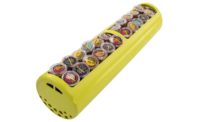The secret life of pests
In order to keep facilities pest-free, managers need to know where pests are hiding inside and outside of their facility.

Some cold storage food facilities believe that pest risks are only found in break rooms and other warm places throughout their facility. The reality is, the entire cold storage facility is just as vulnerable to pests as other types of food facilities. While the chilled environment can be a deterrent for some pests, it is only one aspect of the facility and the environment it is in. In fact, the cold storage environment is perfect for pests, and even allows them to thrive.
Pests are drawn to the many amenities cold storage facilities offer, from the heat given off during the cooling process, to the condensation and even to the abundance of equipment and pipe chases. The shelter, water and food found in these facilities makes it vital for facility managers to understand the proper steps in taking control of pest risks.
Pests’ favorite hangouts
In order to keep facilities pest-free, managers need to know where pests are hiding inside and outside of their facility.
Rooftops. While most facility managers may not have visited the rooftop recently, or even given it much thought, this area can be ground zero for a pest infestation. Shelter under pipes, HVAC housings and water from condensation are the primary areas that provide harbor and forage opportunities to a variety of pests.
One pest that can be particularly problematic on the roof is birds. A parapet wall, poor roof drainage and debris collection make roofs an ideal location for this pest. However, it is more than just the presence of birds and the likelihood of them entering the facility that can be problematic. Bird droppings, which can carry histoplasmosis, pose an interior health risk for both the food and the employees when they accumulate near air intakes of HVAC systems.
Dumpster corral. The dumpster provides consistent resources for all types of pests, including rodents, insects and birds. These pests are attracted to dumpsters, as it is the primary place to grab a bite to eat. Unfortunately, with these pests so close to the facility, it is also very likely they will discover more favorable interior spaces later.
Lot and perimeter. From the landscaping and trees that touch the building, to debris left in the farthest parking space, a facility’s lot can attract and sustain many different pest populations. This can lead to pests traveling into the facility to find other sources of food, water and shelter.
Entryways. Simply put, pests can enter using the front door, just like employees and customers. While some pests may enter from a door being propped open, others will be sneaky by entering through gaps in the weather stripping or damaged doors.
Non-cold storage areas. Most non-chilled interior areas do not hold food, so they are often overlooked as a potential pest risk. However, maintenance areas, drop ceilings, floor voids, storage areas, break rooms, offices, locker rooms, gaps between temperature-controlled areas, the wall or floor and other areas are an important part of a food safety assessment. These areas can harbor rodents and insects or life-supporting items for these pests. Identifying and monitoring these areas is necessary to keeping the entire cold storage facility pest-free.
Cold storage areas. While low temperatures detract many species of rodents and insects, they don’t discourage all pests. In fact, it is not uncommon to find birds living inside coolers and meat departments. Once birds enter a cold storage area, it is important that facility managers understand how challenging it can be to control and eliminate the pest. They need to be aware of the overhead cooling equipment/lines and food safety risks. While eliminating birds is difficult, it can be done, but lasting solutions begin outside of these chilled areas.
The pathway to success
Understanding what pests can be in or near a cold storage facility and where they may be harboring is vital to a pest-free facility. However, facility managers also need to know what to do if a pest is found in or near the building. That’s where the 3-step pathway to pest-free success comes in.
- Annual facility assessment
You cannot manage what you do not know.
The foundation of food safety is an annual facility assessment to discover what is happening at your facility. Your food safety team needs to inspect the facility from top to bottom to discover any gaps in the facility’s pest management approach. Identifying these gaps will allow you to keep food, water and shelter from pests. Finally, it’s important to follow up to ensure there are corrective actions in place to address each gap. This assessment should be done annually, but it can be done on a monthly or quarterly basis to ensure that gaps are identified and closed efficiently.
- Structural inspections
Your maintenance team should conduct its own inspections to ensure that the building is structurally sound (e.g. adequate door seals, etc.) and that designs are not creating environments for pests to thrive (e.g. condensation lines out of alignment with drains). Based in part on the annual facility assessment, any structural conditions that provide life sources for pests should be corrected and monitored. It is best to perform these inspections quarterly, monthly or more frequently based on your facility needs.
- Sanitation inspections
Due to the potential for pest life sources, the sanitation team will need to discover and monitor areas that need regular cleaning. Dumpster corrals, waste bins, damaged product return areas, the parking lot, rooftops and areas prone to condensation should be given extra attention. Develop and update a master cleaning schedule for daily, weekly and monthly cleaning based on facility needs.
While pest control in a cold storage facility may be more difficult than once thought, know that you can turn to a pest management provider as a partner. A pest control company that is dedicated to integrated pest management (IPM) principles will be adept at identifying pest gaps in your food safety program and creating corrective actions when gaps exist. This pest control company will create customized IPM log reports and an annual IPM facility assessment. Then they will review those documents, trends and the facility during the quarterly program reviews. This will ensure that gaps are closed, and corrective actions are implemented, so your facility remains pest-free.
Food safety is a priority at any cold storage facility. With the knowledge of what pests to look out for, where they can be harboring and a pest control partner on your side, you’ll be able to close any gaps and ensure that pest pressure doesn’t put your cold storage food facility at risk.
Looking for a reprint of this article?
From high-res PDFs to custom plaques, order your copy today!





